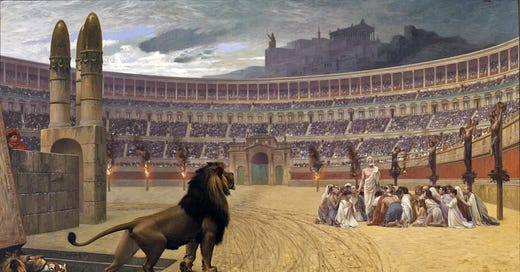The Secrets of the Faith
“To you it has been given to know the mysteries of the kingdom of heaven.”
Matthew 13:11
“The profound and mysterious doctrines are not to be divulged to the uninitiated...”
Origen
Imagine you are a young woman - about 15 years old, and let’s say named Prisca - from a middle-class family in the bustling city of Rome during the mid-3rd century. It is the year we call AD 250, but in the Roman reckoning of the time, it is the Year of the Consulship of Traianus and Gratus. Your days are filled with the familiar routines of household life: helping your mother prepare meals and look after the home, tending to your younger siblings, and thinking about your future - your father is probably arranging your marriage. Outwardly, your life appears ordinary, indistinguishable from that of your neighbours. But you and the whole family carry a secret that could cost you everything.
Yours is a Christian family. By day, you navigate the expectations of Roman society, careful not to betray your true allegiance. At night, a few times a week, under the cover of darkness, you, the eldest, and your father or mother slip away to a hidden meeting, arranged by word of mouth, perhaps in the dimly lit atrium of a trusted friend’s home or in the forgotten and crumbling tunnels of the catacombs beneath the city. Here, in whispered prayers, you enter a world utterly unlike the one outside. This is where your faith takes root: in the sacred, mysterious acts of worship that bind you to Christ and to a community willing to risk death for love of Him, and of each other.
This is the world shaped by the emerging practice known today as the disciplina arcani, the “discipline of the secret”. While Christians in the second century, such as Justin Martyr, had openly discussed rites like baptism and the Eucharist with pagans, by the third century, as persecutions intensified, a heightened emphasis on secrecy took hold. In this time, secrecy was not merely a necessity for survival, it was increasingly seen as a sacred obligation.
In today’s post for paid subscribers, we explore how the need for secrecy under state persecution in the early Church honed a deeper theological understanding of the sacred mysteries in early Christian worship. Facing the threat of betrayal and martyrdom, the early Church not only safeguarded its rites and doctrine, but cultivated profound reverence for the Eucharist, Baptism, and other sacraments. Through practices such as the dismissal of catechumens before the Eucharistic rite in the Mass, Christians reinforced the sanctity of their faith, transforming secrecy into a means of spiritual depth and communal unity. We’ll uncover how the Church Fathers framed this concept of veiled reverence, shaping practices that continue today.
At the Sacred Images Project we talk about Christian life, thought, history and culture through the lens of the first 1200 years of sacred art. The publication is supported by subscriptions, so apart from plugging my shop, there is no advertising or pop-ups. It’s my full time job, but it’s still not bringing a full time income, so I can’t yet provide all the things I want to and am planning for.
You can subscribe for free to get one and a half posts a week.
For $9/month you also get the second half of the third post, plus a weekly paywalled in-depth article on our great sacred patrimony. There are also occasional extras like downloadable exclusive high resolution printable images, ebooks, mini-courses, videos and eventually podcasts.
Something nice for Epiphanytide: at the Met, I found this gorgeous painting by Bartolo di Fredi, a successor (after the Black Death) to the great Sienese masters Duccio di Buoninsegna and Simone Martini, and have created a standing masonite panel print from it.
I think it would make an elegant addition to a prayer corner or mantel.
You can order one here:
Subscribe to join us below:







